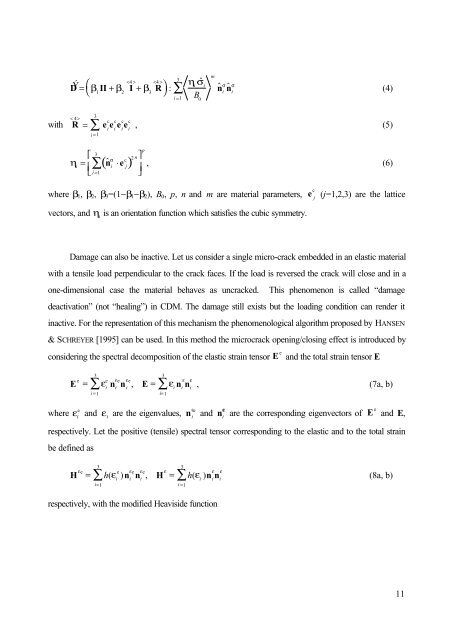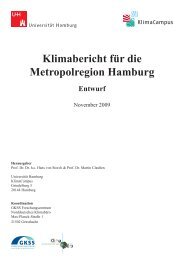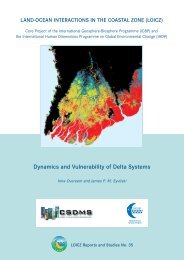ABAQUS user subroutines for the simulation of viscoplastic - loicz
ABAQUS user subroutines for the simulation of viscoplastic - loicz
ABAQUS user subroutines for the simulation of viscoplastic - loicz
Create successful ePaper yourself
Turn your PDF publications into a flip-book with our unique Google optimized e-Paper software.
4><br />
with R<br />
D Ý = β II + β I<br />
1 2 <br />
+ β R 3 <br />
⎛<br />
⎞<br />
⎝<br />
⎠ :<br />
3 η ˆ iσ i<br />
n ˆ σ ˆ σ ∑ i n i<br />
(4)<br />
⎡<br />
ηi =<br />
⎣<br />
⎢<br />
3<br />
i=1<br />
B 0<br />
m<br />
c c c c<br />
= ∑ e ei ei ei , (5)<br />
i<br />
i=1<br />
3<br />
∑<br />
j=1<br />
σ c ( n ˆ i ⋅e j)<br />
2n⎤<br />
⎦<br />
⎥<br />
p<br />
, (6)<br />
c<br />
where β1, β2, β3=(1−β1−β2), B0, p, n and m are material parameters, e j (j=1,2,3) are <strong>the</strong> lattice<br />
vectors, and η i is an orientation function which satisfies <strong>the</strong> cubic symmetry.<br />
Damage can also be inactive. Let us consider a single micro-crack embedded in an elastic material<br />
with a tensile load perpendicular to <strong>the</strong> crack faces. If <strong>the</strong> load is reversed <strong>the</strong> crack will close and in a<br />
one-dimensional case <strong>the</strong> material behaves as uncracked. This phenomenon is called “damage<br />
deactivation” (not “healing”) in CDM. The damage still exists but <strong>the</strong> loading condition can render it<br />
inactive. For <strong>the</strong> representation <strong>of</strong> this mechanism <strong>the</strong> phenomenological algorithm proposed by HANSEN<br />
& SCHREYER [1995] can be used. In this method <strong>the</strong> microcrack opening/closing effect is introduced by<br />
considering <strong>the</strong> spectral decomposition <strong>of</strong> <strong>the</strong> elastic strain tensor E e and <strong>the</strong> total strain tensor E<br />
3<br />
E e e εe εe<br />
ε ε<br />
= ∑ εi ni ni , E = ∑ εi ni ni , (7a, b)<br />
i=1<br />
3<br />
i=1<br />
e εe e e<br />
where εi and εi are <strong>the</strong> eigenvalues, ni and ni are <strong>the</strong> corresponding eigenvectors <strong>of</strong> E and E,<br />
respectively. Let <strong>the</strong> positive (tensile) spectral tensor corresponding to <strong>the</strong> elastic and to <strong>the</strong> total strain<br />
be defined as<br />
3<br />
H εe e εe εe<br />
= ∑ h(εi )ni ni , H ε ε ε<br />
= ∑ h(εi )n ini<br />
(8a, b)<br />
i=1<br />
respectively, with <strong>the</strong> modified Heaviside function<br />
3<br />
i=1<br />
11





